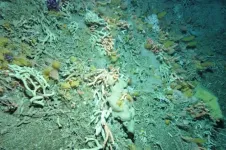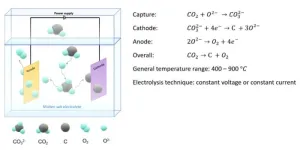(Press-News.org) New research led by the University of East Anglia (UEA) reduces uncertainty in future climate change linked to the stratosphere, with important implications for life on Earth.
Man-made climate change is one of the greatest challenges facing us today, but uncertainty in the exact magnitude of global change hampers effective policy responses.
A significant source of uncertainty relates to future changes to water vapour in the stratosphere, an extremely dry region of the atmosphere 15–50 km above the Earth’s surface.
Future increases in water vapour here risk amplifying climate change and slowing down the recovery of the ozone layer, which protects life on Earth from harmful solar ultraviolet radiation.
Now an international team led by Peer Nowack, until recently a member of the Climatic Research Unit at UEA, has developed a new statistical learning approach that combines information from satellite observations with state-of-the-art climate model data to narrow the range of likely future stratospheric water vapour amounts.
One of the key results, published today in the journal Nature Geoscience, effectively rules out the most extreme scenarios, which imply that water vapour concentrations could increase by more than 25% per degree of global warming. The new approach represents a 50% reduction in the 95th percentile of climate model responses.
“Man-made climate change affects Earth’s atmosphere in many important and often surprising ways,” said Prof Nowack, now at the Institute of Theoretical Informatics at the Karlsruhe Institute of Technology, Germany.
“In our paper, we look at changes in stratospheric water vapour under global warming, an effect that is still poorly understood. Since water vapour is central to the physics and chemistry of the stratosphere, I felt that we crucially need a new approach to address this longstanding uncertainty factor.
“With our new data-driven approach, which exploits machine learning ideas, we were able to make highly effective use of Earth observations to reduce this uncertainty. This required us to develop a framework in which we could combine scientific understanding and mathematical relationships learned from satellite data in innovative ways.”
“With this approach, we were able to show that many climate model projections of very large stratospheric water vapour changes are now inconsistent with observational evidence,” said co-author Dr Sean Davis, a Research Scientist at the National Oceanic and Atmospheric Administration in the US, specializing in satellite measurements of stratospheric water vapour.
Quantifying stratospheric water vapour trends under global warming is a longstanding research challenge. The complexity of the underlying processes that control stratospheric water vapour and the relatively short record of high-quality satellite observations has made this task difficult.
The presence of so-called climate feedbacks presents an additional challenge, as these can act to further amplify or dampen global warming, therefore leading to a wider range of possible future temperature increases.
The amount of water vapour that the stratosphere holds is an example of one such feedback, which climate models have predicted to increase, but the range of modelled increases has remained very wide for decades.
This is important, because large climate-driven increases in stratospheric water vapour, like those projected by many climate models, could delay the recovery of the ozone layer and of the Antarctic ozone hole over the course of this century.
However, Manoj Joshi, Professor of Climate Dynamics at UEA and a co-author on the paper, said: “Our research implies that while stratospheric water vapour concentrations are still likely to increase with global warming, the large changes that could substantially delay ozone recovery are highly unlikely.”
The research was funded by the UK Natural Environment Research Council (NERC) through the ML4CLOUDS project.
‘Response of stratospheric water vapour to warming constrained by satellite observations’, Peer Nowack et al, is published in Nature Geoscience on 26 June 2023.
END
Study of Earth’s stratosphere reduces uncertainty in future climate change
2023-06-26
ELSE PRESS RELEASES FROM THIS DATE:
New study reveals brain's potential to regulate fentanyl consumption, offering hope in the fight against opioid addiction
2023-06-26
The opioid crisis continues to pose a grave public health concern, with synthetic opioids such as fentanyl posing a major risk for development of addiction and death due to overdose. In a ground-breaking development, a recent study by the research group led by Prof. Ami Citri at the Hebrew University of Jerusalem's Edmond and Lily Safra Center for Brain Sciences has unveiled crucial insights into the brain's potential ability to regulate the urge to consume fentanyl. This discovery offers a glimmer of hope in the ongoing battle against ...
Supplemental Nutrition Assistance Program access and racial disparities in food insecurity
2023-06-26
About The Study: Racial disparities in food insecurity were found among low-income households that do not participate in Supplemental Nutrition Assistance Program (SNAP) but not among those that do, suggesting that access to SNAP should be improved. These results also highlight the need to examine the structural and systemic racism in food systems and in access to food assistance that may contribute to disparities.
Authors: Laura J. Samuel, Ph.D., R.N., of the Johns Hopkins School of Nursing in Baltimore, is the corresponding author.
To access the embargoed study: Visit our For The Media website at this link https://media.jamanetwork.com/
(doi:10.1001/jamanetworkopen.2023.20196)
Editor’s ...
Study of deep-sea corals reveals ocean currents have not fuelled rise in atmospheric carbon dioxide
2023-06-26
Pioneering analysis of deep-sea corals has overturned the idea that ocean currents contributed to increasing global levels of carbon dioxide in the air over the past 11,000 years.
The study, led by the University of Bristol in the UK and Nanjing University in China, examined historic deep-sea corals to shed intriguing new light on the history of ocean chemistry.
Understanding what has led to the pre-industrial rise in carbon dioxide (CO2) levels during the Holocene period, which dates back some 11,700 years to the present day, is a source of scientific debate. One theory suggests the increase in physical ...
Tuning T cell traits and functions with biomechanical materials
2023-06-26
By Benjamin Boettner
(Boston) — The successful campaign of adoptive T cell therapies, a type of immunotherapy in which immune T cells are collected from a patient, enhanced outside of the body, and reinfused back into the same patient, especially against blood cancers is well under way. But improving the ability to create patient-specific T cell populations with specific traits and functions could broaden clinicians’ repertoire of T cell therapies.
One way to approach this goal is to better understand how T cells’ traits and functions, including their cytotoxic effects on ...
New understanding of why kidney cancers become metastatic discovered by MD Anderson researchers
2023-06-26
HOUSTON ― Researchers at The University of Texas MD Anderson Cancer have engineered a new model of aggressive renal cell carcinoma (RCC), highlighting molecular targets and genomic events that trigger chromosomal instability and drive metastatic progression.
The study, published today in Nature Cancer, demonstrates that the loss of a cluster of interferon receptor (IFNR) genes plays a pivotal role in allowing cancer cells to become tolerant of chromosomal instability. This genomic feature may be used to help clinicians predict a tumor’s potential to become metastatic and treatment resistant.
Researchers led by Luigi Perelli, ...
Dry days trigger leaves to send a surprising growth signal telling roots to keep growing
2023-06-26
Scientists at the Sainsbury Laboratory Cambridge University (SLCU) have discovered a new molecular signalling pathway, triggered when leaves are exposed to low humidity, that ensures plant roots keep growing towards water.
In dry soil conditions, plants take action to try and conserve water by producing the drought stress hormone abscisic acid (ABA). For decades plant scientists thought that in response to dry soil, ABA was made in the roots and then transported to the leaves. In this root-to-shoot signalling pathway, ABA closes microscopic leaf pores, called stomata, to prevent water loss from leaves. In recent years, scientists ...
Study on rare antibodies hints at strategy tweaks that may future-proof COVID-19 vaccines
2023-06-26
New research examining how frequently our bodies produce broadly neutralizing antibodies (bnAbs) capable of thwarting a range of SARS-CoV-2 variants offers clues on the strategy tweaks that could potentially future-proof COVID-19 vaccines.
To counter invading viruses, our body deploys specific antibodies, among them the neutralizing kind targeting the receptor-binding domain (RBD) — the “Velcro hooks” used by pathogens to fasten onto our cells. As SARS-CoV-2 accumulates genetic mutations, new variants emerge donning sneaky disguises to outsmart our defenses. So-called bnAbs are elite neutralizing antibodies that can keep up ...
Overview of CO2 capture and electrolysis technology in molten salts: operational parameters and their effects
2023-06-26
Carbon dioxide capture, storage, and utilization have been widely researched to achieve CO2 zero emission and resolve climate change issues. Molten salt electrolysis is one promising method to simultaneously capture and convert CO2 into valuable carbon materials and oxygen with high current efficiencies, to provide a promisingly positive cash flow. However, this method still requires investigation for future scale-up applications. A team of scientists reviews the molten salt CO2 electrolysis’s ...
Researchers urge caution in gene editing early human embryos following findings that it could have unexpected and dangerous consequences Further research to refine gene editing technology is needed
2023-06-26
Copenhagen, Denmark: Scientists have discovered that the cells of early human embryos are often unable to repair damage to their DNA. The researchers say that this has important implications for the proposed use of gene editing techniques to remove serious inherited diseases from embryos, as well as for IVF in general.
Presenting the research to the 39th annual meeting of the European Society of Human Reproduction and Embryology (ESHRE) [1], Dr Nada Kubikova from the University of Oxford (UK), said: “Gene editing has the potential to correct defective genes, a process that usually involves first breaking and then ...
New sensor chip advances rapid, cost-effective disease diagnostics
2023-06-26
Media Inquiries to Laura Muntean, laura.muntean@ag.tamu.edu, 6012481891
Written by Gabe Saldana, 956-408-5040, gabe.saldana@ag.tamu.edu
Texas A&M AgriLife Research scientists and collaborators at Iowa State University have developed a sensor chip that can detect many disease pathogens with 10 times the sensitivity of currently available methods.
The chip also eliminates the need for chemical dye reagents typically used in the diagnostic process. The new technology shows promise for rapid, low-cost point-of-care diagnostic capabilities in plants, foods, animals and humans, including detecting foodborne pathogens, bird flu and COVID-19.
An ...



